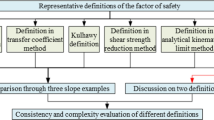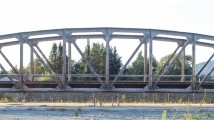Abstract
Accurate condition assessment and monitoring of concrete bridge deck deterioration progression requires both use of multiple nondestructive evaluation (NDE) technologies and automation in data collection and analysis. RABIT (robotics assisted bridge inspection tool) for bridge decks enables fully autonomous data collection at rates three or more times higher than it is typically done by a team of five inspectors using manual NDE technologies. The system concentrates on the detection and characterization of three most common internal deterioration and damage types: rebar corrosion, delamination, and concrete degradation. For that purpose, RABIT implements four NDE technologies: electrical resistivity (ER), ground-penetrating radar (GPR), impact echo (IE) and ultrasonic surface waves (USW) method. High productivity and higher spatial data resolution are achieved through the use of large sensor arrays or multiple probes for the four NDE methods. RABIT surveys also complement visual inspection by collecting high resolution images of the deck surface, which can be used for crack mapping and documentation of deck spalling, previous repairs, etc. The NDE technologies are used in a complementary way to enhance the overall condition assessment, certainty regarding the detected deterioration and better identification of the primary cause of deterioration. RABIT’s components, operation, field implementation and validation, as well as future integration with a robotic platform for minimally invasive rehabilitation, are described.














Similar content being viewed by others
References
ASTM: ASTM Standard D6087-08—standard test method for evaluating asphalt-covered concrete bridge decks using ground penetrating radar. ASTM, West Conshohocken (2008)
ASTM: ASTM C876-09 Standard: standard test method for half cell potentials of reinforcing steel in concrete. American Society for Testing and Materials, West Conshohocken (2009)
Barnes, C.L., Trottier, J.-F.: Ground penetrating radar for network level concrete deck repair management. J. Transp. Eng. 126(3), 257–262 (2000)
Brown, R.D.: Mechanisms of corrosion of steel in concrete in relation to design, inspection, and repair of offshore and coastal structures. In: ACI (ed.) SP-65: Performance of concrete in marine environments, pp. 169–204. ACI, Michigan (1980)
Carino, N.J.: The impact-echo method: an overview. In: ASCE, Chang P.C. (eds.) Proc. structures congress and exposition, Washington (2001)
Gibson, A., Popovics, J.S.: Lamb wave basis for impact-echo method analysis. J. Eng. Mech. 131(4), 438–443 (2005)
Gowers, K.R., Millard, S.G.: Measurement of concrete resistivity for assessment of corrosion severity of steel using Wenner technique”. ACI Mater. J. 96(5), 536–542 (1999)
Gucunski, N., Consolazio, G.R., Maher, A.: Concrete bridge deck delamination detection by integrated ultrasonic methods. Int. J. Mater. Prod. Technol. 26(1–2), 19–34 (2006)
Gucunski, N., Rascoe, C., Parrillo, R., Roberts, R.: Comparative study of bridge deck condition assessment by high frequency GPR. In: Proc. of the ASNT’s NDE/NDE for highways and bridges: structural materials technology (SMT) conference, Oakland (2008)
Gucunski, N., Parvardeh, H., Romero, F., Pailes, B.M.: Deterioration progression monitoring in concrete bridge decks using periodical NDE surveys. In: Proc. second conference on smart monitoring, Assessment and Rehabilitation of Civil Structures, Istanbul (2013)
Gucunski, N., Imani, A., Romero, F., Nazarian, S., Azari, H., Wiggenhauser, H., Shokouhi, P., Taffe, A., Kutrubes, D.: Nondestructive testing to identify concrete bridge deck deterioration. Report S2-R06A-RR-1, SHRP2 Renewal Research, Transportation Research Board, Washington (2013)
Gucunski, N., Pailes, B., Kim, J., Azari, H., Dinh, K.: Capture and quantification of deterioration progression in concrete bridge decks through periodical NDE Surveys. Infrastruct. Syst. 23(1), (2017). doi:10.1061/(ASCE)IS.1943-555X.0000321 (B4016005)
Kim, J., Gucunski, N., Duong, T., Dinh, K.:Three-dimensional visualization and presentation of bridge deck condition based on multiple NDE data. J. Infrastruct. Syst. 23(3), (2017). doi:10.1061/(ASCE)IS.1943-555X.0000341
La, H.M., Lim, R.S., Basily, B.B., Gucunski, N., Yi, J., Maher, A., Romero, F.A., Parvardeh, H.: Mechatronic systems design for an autonomous robotic system for high-efficiency bridge deck inspection and evaluation. IEEE/ASME Trans. Mechatron. 18(6), 1655–1656 (2013)
Lim, R.S., La, H.M., Shan, Z., Sheng, W.: Developing a crack inspection robot for bridge maintenance. In: Proc. 2011 IEEE Intl. Conf. on robotics and automation, Shanghai. pp. 6288–6293 (2011)
Lin, J.M., Sansalone, M.: A procedure for determining P-wave speed in concrete for use in impact-echo testing using a Rayleigh wave speed measurement technique. In: Pessiki, S., Olson, L. (eds.) Innovations in nondestructive testing, SP-168, pp. 137–165. American Concrete Institute, Farmington Hills (1997)
Maser, K.R., Rawson, A.: Network bridge deck surveys using high speed radar: Case studies of 44 decks (abridgement). Transportation Research Record, Transportation Research Board, 1347, National Research Council, Washington. pp. 25–28 (1992)
Nazarian, S., Baker, M.R., Crain, K.: Report SHRP-H-375: development and testing of a seismic pavement analyzer. National Research Council, Washington (1993)
Pailes, B.M.: Damage identification, progression, and condition rating of bridge decks using multi-modal non-destructive testing. Doctoral Dissertation, Rutgers University, Piscataway (2014)
Raupach, M., Reichling, K., Wiggenhauser, H., Stoppel, M., Dobmann, G., Kurz, J.: BETOSCAN: An instrumented mobile robot system for the diagnosis of reinforced concrete floors. In: Proc. 2nd Intl. Conf. on Concrete Repair, Rehabilitation and Retrofitting II, ICCRRR-2, November 24–26, 2008, pp. 651–655. CRC Press, Cape Town (2009)
Roberts, G.E., Roberts, R.L., Tarussov, A.: Identifying concrete deterioration using ground penetrating radar technology. In: Proc., Annual ASNT Fall Conference (2001)
Sansalone, M.: Impact-echo: the complete story. ACI Mater. J. 94(6), 777–786 (1997)
Wiggenhauser, H.: Advanced NDT methods for the assessment of concrete structures. In: Proc. 2nd Intl. Conf. on concrete repair, rehabilitation and retrofitting II, ICCRRR-2, November 24–26, 2008, pp. 21–33. CRC Press, Cape Town (2009)
Wiggenhauser, H., Niederleithinger, E.: Innovative ultrasonic techniques for inspection and monitoring of large concrete structures. In: Proc. Intl. Work. NUCPERF 2012 (RILEM Event TC 226-CNM and EFC Event 351), EPJ Web of Conferences, 56, EDP Sciences (2013)
Yuan, D., Nazarian, S., Chen, D., Hugo, F.: Use of seismic pavement analyzer to monitor degradation of flexible pavements under texas mobile load simulator, pp. 3–10. National Research Council, Washington (1999)
Acknowledgements
RABIT was developed under DTFH61-08-C-00005 contract from the US Department of Transportation—Federal Highway Administration (USDOT-FHWA). The authors sincerely acknowledge this FHWA’s support through the Long Term Bridge Performance Program, especially Drs. Hamid Ghasemi and Robert Zobel. The authors are also grateful to the Virginia Department of Transportation (VDOT) for its cooperation in providing access to the Haymarket Bridge and Warren County Engineer’s office that allowed access to the Pohatcong Bridge. ANDERS NRI robotic system development was supported under the research project entitled “Automated Nondestructive Evaluation and Rehabilitation System (ANDERS) for Concrete Bridge Decks”. The project was funded by the National Institute of Standard Technology (NIST) under its Technology Innovation Program (TIP) under award 70NANB10H014. The support of the NIST-TIP for the ANDERS project is gratefully acknowledged. The work on the model and formation control framework development for multi-robot coordination and human-robot collaboration is supported by NSF-NRI: Collaborative Research award IIS-1426828 through project entitled: “Minimally Invasive Robotic Non-Destructive Evaluation and Rehabilitation for Bridge Decks (Bridge-MINDER)”. The support of the NSF-NRI for the Bridge-MINDER project is gratefully acknowledged. Finally, the authors are grateful to the previous or current research staff at Rutgers’ School of Engineering and Center for Advanced Infrastructure and Transportation (CAIT), especially Professors Kristin Dana, Perumalsamy Balaguru and Husam Najm, research engineer Hooman Parvardeh, and former research staff and graduate students, Dr. Hung La, Dr. Matthew Klein, Ronny Lim, Parneet Kaur and Prateek Prasanna.
Author information
Authors and Affiliations
Corresponding author
Rights and permissions
About this article
Cite this article
Gucunski, N., Basily, B., Kim, J. et al. RABIT: implementation, performance validation and integration with other robotic platforms for improved management of bridge decks. Int J Intell Robot Appl 1, 271–286 (2017). https://doi.org/10.1007/s41315-017-0027-5
Received:
Accepted:
Published:
Issue Date:
DOI: https://doi.org/10.1007/s41315-017-0027-5




